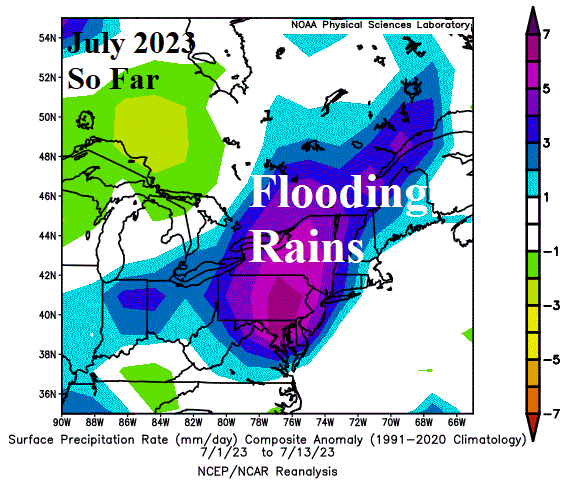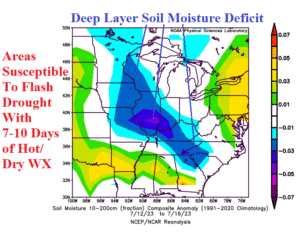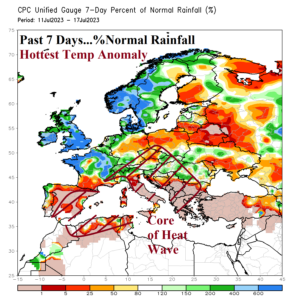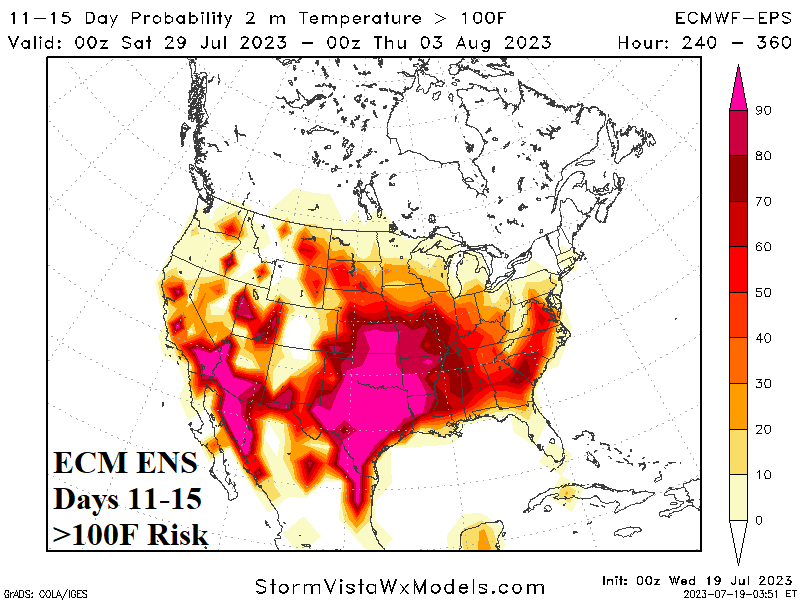
The Wetter Pattern Change in the Northeast U.S.
07/16/2023, 12:37 pm EDT
Northeast Pacific Marine Heat Wave Shifts To Coast; New Marine Heat Wave Off Newfoundland
07/23/2023, 3:41 pm EDT

Fig. 1-2: ECM ENS medium-range forecast of >100F risk is expanding northward and eastward especially in the 11-15-day period.
Discussion: The historic California, Southwest U.S., and Texas heatwave of mid-July will expand across the U.S. to close the month. The risk of >100F shifts across much of the Great Plains to the Mid-south States in the 6-10-day period (Fig. 1). In the 11-15-day period, the risk of >100F shifts eastward through the southern Ohio Valley, Tennessee Valley, and into the Mid-Atlantic States (Fig. 2). The GFS ENS forecast is hotter. The peak maximum temperature range (ECM-GFS ENS) of 97-101 in Des Moines, IA begins next Thursday (July 27). Complicating the effects of heat on crops is the attendant dry pattern. The GFS 15-day forecast is dry and trending drier for much of the U.S. AG Belt (Fig. 3). The drier/hotter climate is an emerging concern despite the weakening drought in the Midwest U.S. during the first half of July. Deep layer soil moisture deficits stretching from eastern Iowa and especially Illinois southeastward to the eastern Tennessee Valley (Fig. 4) identify areas that remain susceptible to quickly re-intensifying drought if a lengthy period (7-10 days) of extreme heat and lack of rain are observed.


Fig. 3-4: The GFS 15-day rainfall anomaly forecast and deep layer soil moisture analysis across the U.S. AG Belt.

Fig. 5: Core of the recent heatwave across Southern Europe and the 7-day percent of normal rainfall.
During the past 7 days, no rain and searing heat has struck far northwestern Africa, east and south Spain, all of Italy, and Southeast Europe (Fig. 5). The hot weather extends farther north into Southwest Poland although the northern reach of the heatwave has been accompanied by thunderstorm activity. Rapidly evolving drought in Southern Europe is generated by this hostile heatwave. Previously issued Europe Drought Observatory (EDO) soil moisture analysis revealed that on July 1st 42% of Europe was in drought warning status and much of that drought risk area was in Central and East/Northeast Europe. Southern expansion is expected in the next EDO analysis. The outlook for the remainder of July maintains a dry and very hot pattern for Italy and Southeast Europe while to the north a steady cooldown is likely, and the recent Western Europe rains will shift eastward.
![Climate-Impact-Company-logo-sm[1]](https://climateimpactcompany.com/wp-content/uploads/2023/08/Climate-Impact-Company-logo-sm1.png)
